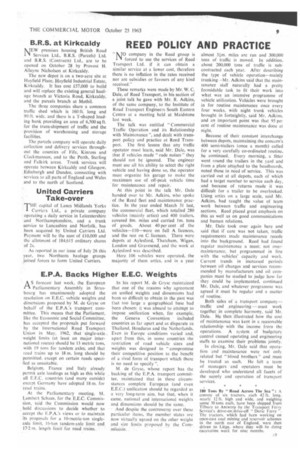REED POLICY AND PRACTICE
Page 11

If you've noticed an error in this article please click here to report it so we can fix it.
" MO company in the Reed group is forced to use the services of Reed Transport Ltd. if it can obtain a similar service at a lower cost, therefore there is no inflation in the rates received nor are subsidies or favours of any kind received."
These remarks were made by Mr. W. C. Dale, of Reed Transport, in his section of a joint talk he gave with Mr. R. Adkins, of the same company, to the Institute of Road Transport Engineers South Eastern Centre at a meeting held at Maidstone last week.
The talk was entitled "Commercial Traffic Operation and its Relationship with Maintenance", and dealt with transport policy and practice at Reed Transport. The first lesson that any traffic operator must learn, said Mr. Dale, was that if vehicles made " rude noises" they should not be ignored. The engineer must use all his ability to select the right vehicle and having done so, the operator must organize his garage to make the maximum use of off-peak vehicle time for maintenance and repair.
At this point in the talk Mr. Dale handed over to Mr. Adkins, who spoke of the Reed fleet and maintenance practice. In the year ended March 31 last, the commercial fleet, which totalled 280 vehicles (mainly artics) and 400 trailers, covered 8m. miles and carried 1m. tons of goods. About 40 per cent of the vehicles-110—were on full A licences, and the rest on C licences. There were depots at Aylesford, Thatcham, Wigan, London and Gravesend, and the work at Aylesford was described.
Here 106 vehicles were operated, the majority of them artics. and in a year
almost 31m. miles arc run and 300,000 tons of traffic is moved. In addition. about 200,000 tons of traffic is subcontracted each year. After describing the type of vehicle operation—mainly trunking—Mr. Adkins said that the maintenance staff naturally had a pretty formidable task to fit their work into what was an intensive programme of vehicle utilization. Vehicles were brought in for routine maintenance once every four weeks, with night trunk vehicles brought in fortnightly, said Mr. Adkins, and an important point was that 95 per cent of routine maintenanee was done at night.
Because of their constant interchange between depots, maintaining the concern's 400 semi-trailers (once a month) called for a very carefully co-ordinated routine, he continued. Every morning, a fitter went round the trailers in the yard and from a plate attached to the headboards, noted those in need of service. This was carried out at all depots, each of which had a target number to service each day, and because of returns made it was difficult for a trailer to be overlooked. Using artics on a large scale, said Mr. Adkins, had taught the value of team work between traffic and engineering sections. Reed placed great emphasis on this as well as on good communications and human relations.
Mr. Dale took over again here and said that if care was not taken, traffic requirements made maintenance recede into the background. Reed had found regular maintenance a must; not overmaintenance, but programmed in line with the vehicles' capacity and work. Current trends in increased periods between oil changes and services recommended by manufacturers and oil companies must be studied to judge how far they could be implemented, continued Mr. Dale, and whatever programme was agreed it must be regular and a matter of routine.
Both sides of a transport company— traffic and _engineering — must work together in complete harmony, said Mr. Dale. He then illustrated how the cost of maintenance was kept in a reasonable relationship with the income from the operations. A system of budgetary control caused operating and engineering staffs to examine their problems jointly.
In closing, Mr. Dale said that operation and maintenance were not only related but " blood brothers" and must be treated as such. He felt a learn of managers and operators must be developed who understand all facets of the supply and operation of transport services.
180 Tons By "Road Across The Sea ": A convoy of six tractors. each 42 ft. long. nearly 12 ft. high and wide, and weighing some 10 tons each, have been shipped from Tilbury to Antwerp by the Transport Ferry Service's drive-onidrive-off " Doric Ferry The tractors, which had been working on open-cast coal mining and reservoir schemes in the north east of England, were then driven to Liege, where they willhe doing excavation work for nine months.




























































































